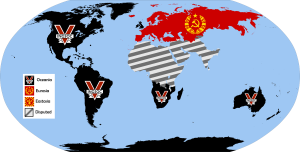By Martin H. Levinson
The three “R”s—reading, ‘riting, and ‘rithmetic—were the mainstays of our education system for many years. But students in the 21st century live in a technologically and media-rich environment that demands a new model be put in place. I propose it be the three “I”s—imaging, interneting, and integer punching (on calculators).
The inclusion of imaging in the curriculum is based on the notion that, since a picture is worth a thousand words, it makes no sense to use language to communicate thoughts and ideas. Need to write a thousand-word essay? Show a picture instead. Assigned a term paper? Five to ten illustrations should do the trick. Have to deliver a lecture? Save your voice and hold up a few photos.
Images have a big advantage over words as they can be grasped right away. For example, why spend hours reading books and articles on World War II when you can watch Saving Private Ryan and learn what the war was about quickly. Want to get the gist of the novel War and Peace? Watch the TV mini-series, which is far less time consuming and easier to follow than the book, and you can eat, drink, text, and exercise while viewing the programs.
If a picture is worth a thousand words, what’s a video worth? The answer is about a million people. Statistics show in the United States 75 million individuals watch videos online each month and 40 billion videos are streamed monthly.
Images appeal to our emotions more viscerally than language does and that’s a huge plus, as thinking about things is hard work. Moreover, images are subject to interpretation, which makes them lots more interesting than facts—though, to be fair, not to people like Kellyanne Conway who believe facts are also subject to interpretation.
To put the emphasis on image education in school, reading teachers should be phased out and photography and film instructors phased in; the SAT exam should include a section requiring drawn responses to pictures; and comic books should replace textbooks in English classes. Implementing these ideas would put our nation in a better position to meet the educational challenges of the new millennium, because in a world where TV shows and videos are major sources of information, it’s not what you know, it’s what you can show.
Interneting is the second leg of the three-I model. Before emails, people frequently connected with each other by writing letters, which meant you had to know something about the rules of grammar, usage, and correct spelling. But there’s no longer a need to master such archaic practices because, as the following poem shows, sentence fragments and phonetically spelled words are more than enough to get messages across.
Eye halve a spelling checker
It came with my pea sea
It plainly marks four my revue
Miss steaks eye kin knot sea.
Eye strike a key and type a word
And weight four it two say
Weather eye am write oar wrong
It shows me strait a weigh.
Since formal writing has become outmoded it should be jettisoned from the curriculum and interneting, which includes the use of chat speak (e.g., lol, btw, omg) and emoticons (visual representations of emotions), should take its place. Interneting is cooler and way more efficient in communicating with others than using cheerless Standard English—to wit: “When I watched the sun, in all its magnificent and resplendent glory, come up over the mountains this morning I felt tremendously appreciative and happy to be alive” versus “OMG, Sunrise 🙂 !”
The last of the three “I”s, integer-punching, involves using a calculator to do arithmetic computations. The process is easy to learn and does away with having to master addition, subtraction, multiplication, and division. Once students get the hang of it they can forget about math and shift their focus to what really matters; doing things like trying to become an influencer, trolling people on social media, taking selfies, and playing video games.
Note to teachers: Students should be told that calculators are not magic. A person still has to know how to think, specifically, one needs to remember where he or she put their calculator. (Happily, if that information does not come to mind, as a back up, you can always ping it.)
Imaging, interneting, and integer-punching—for effective, up-to-date, state-of-the-art education in the twenty-first century, the “I”s have it!






Be First to Comment